IT Service Management Automation: Meaning, Features, & Tools
IT Service Management (ITSM) is an integral part of any capable IT department or MSP. The global market size of ITSM is predicted to grow between 2023 and 2030. The estimated value was USD 8.99 billion in 2022, with an expected CAGR of 9.3% from 2023 to 2030.
To supercharge your ITSM though, you could consider employing dedicated automation that streamlines workflows to make your daily workload that much more optimized.
Part 1: What Is ITSM Automation?
IT service management automation refers to the use of technology tools and software to automate various processes and tasks for managing and delivering IT services. Its purpose is to improve the efficiency, reliability and consistency of IT services, reduce human errors, and optimize resource utilization.
Here are some major cases where MSPs want to use IT Service Management Automation:
Automation of repetitive tasks: For some repetitive tasks, such as password resets, user account management, and software updates, automation can reduce manual workload and reduce error rates.
Incident and fault management: Automation can help quickly detect and respond to incidents and faults in IT systems.
Change management: When implementing system updates or configuration changes, automation tools can ensure the standardization and consistency.
Configuration management: Automation can help maintain accurate records of IT assets and configuration items, ensuring that the data in the configuration management database (CMDB) is always up to date.
Patch management: Automation tools can regularly scan system vulnerabilities and automatically deploy patches to ensure the security and stability of the system.
By implementing IT service management automation, enterprises can improve IT operational efficiency, provide higher quality services, and support the achievement of business goals.
Part 2: Key Features of ITSM Automation
These are some key features of ITSM automation to give you a better idea of the types of processes it can handle to streamline your ITSM processes:
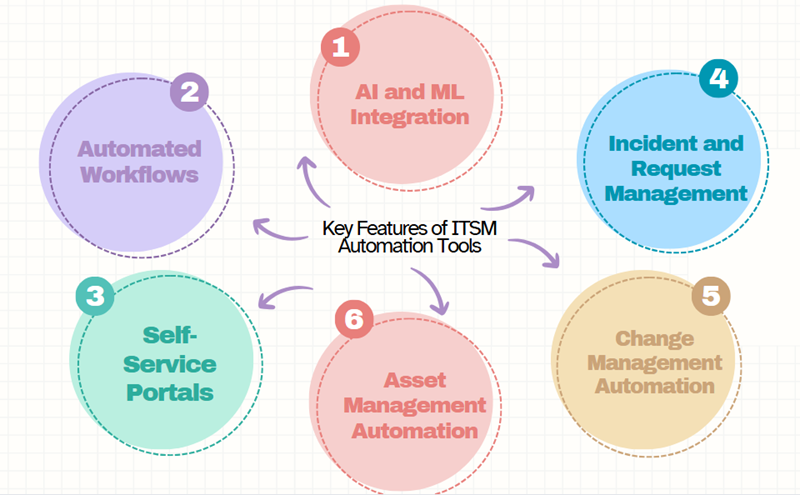
AI and ML Integration
The key to the transformation of ITSM is the increasing use of AI and machine learning.
They play a pivotal role in ITSM automation like with AI-driven chatbots and virtual agents that provide instant support for the ‘easier’, and more common user queries which reduces the workload on IT help desks.
Machine learning algorithms can analyze historical data to identify patterns, predict potential issues and threats, and recommend preventative measures to enable proactive IT management.
Automated Workflows
With automated workflows, processes like incident resolution, service requests, and approvals are streamlined and eliminate the need for manual intervention. For example, if there’s a password reset request, automated workflows can authenticate the user, reset the password, and notify them without any human involvement.
Self-Service Portals
Self-service portals are an invaluable tool to empower users to resolve issues on their own. This could come in the form of knowledge base articles, FAQs, and troubleshooting guides. Augmenting the portal with AI-powered recommendations can speed up the process, ensuring users find relevant solutions quickly.
Incident and Request Management
You can also automate your incident and request management processes by automatically categorizing, prioritizing, and assigning tickets based on predefined rules. This simplifies the process and ensures resources are allocated efficiently and issues are addressed promptly.
Change Management Automation
With change management automation, the process now standardizes the planning, approval, and implementation of changes in IT systems. These automated workflows ensure that all changes are documented, risks assessed, and the necessary approvals are obtained before the changes go live.
Asset Management Automation
Deploying an asset management automation can help businesses track and manage IT assets throughout their lifecycle. This helps you keep track of all IT infrastructure assets from procurement to disposal to ensure accurate inventory records, assess utilization optimization, and to reduce costs.
Part 3: Top ITSM Automation Tools
Since you have learned what IT service management automation is, and how important it is, it’s time to review and choose the ITSM automation tools that fully streamline your daily workflow.
1ServiceNow
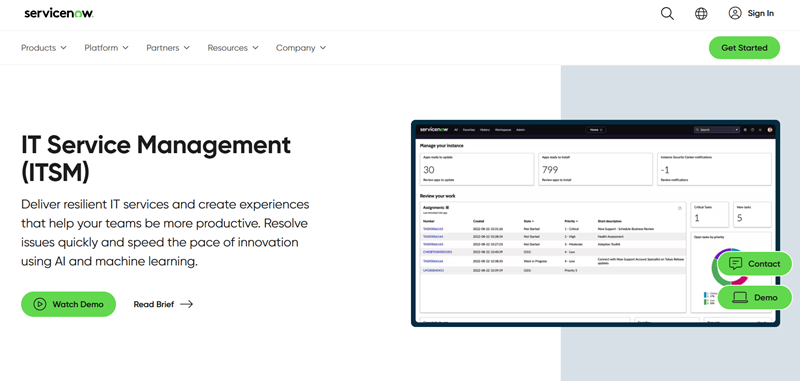
ServiceNow is a comprehensive and prominent ITSM option with an ensuite of cloud-based services for automation by consolidating their IT services and tools into one convenient enterprise-grade platform.
With the assistance of its generative AI ‘Now’ platform, you can expect increased productivity while availing advanced features designed to scale with your business as it grows.
You can expect most of the AI and ITSM features from these types of platforms, but ServiceNow utilizes a unique single data model architecture which allows for a more intuitive and seamless experience across their modules & third-party systems.
Key Features:
1. ‘Now’ platform Generative AI to accelerate productivity
2. ‘Predictive Intelligence’ built-in machine learning
3. Comprehensive real-time analytics
Pros:
1. Extensive customization and integration w/ third-party tools & platforms
2. Highly scalable for enterprise usage
Cons:
High licensing and implementation costs
Best For: Large enterprises looking for a comprehensive ITSM solution with extensive automation and integration capabilities.
User Review: 4.4/5 (from G2)
Editor’s Rating:
Automation Capabilities: ⭐⭐⭐⭐⭐
Customization and Flexibility: ⭐⭐⭐⭐⭐
UI Experience: ⭐⭐⭐⭐⭐
2Jira Service Management by Atlassian

Atlassian’s Jira Service Management is a versatile ITSM platform that seamlessly integrates with Atlassian’s ecosystem as well as third-party platforms like Slack, making it a popular choice for Agile and DevOps teams.
Built on the Jira platform it offers familiar and powerful workflows, SLA management, and collaboration tools.
Additionally, Jira Service Management is well-regarded for its incredibly user-friendly and intuitive interface while keeping things cost-effective thanks to reasonable pricing strategies.
This makes it more catered to smaller businesses that require an ITSM solution but this also means for larger organizations, its ‘simplicity’ may limit how effective it can be for more complex environments.
Key Features:
1. AI-powered virtual service agent w/ direct integration into Slack
2. Advanced, real-time analytics and reporting
3. Customizable workflows & templates for diverse use cases and teams
Pros:
1. User-friendly and intuitive UI design
2. Integrates well with other Atlassian tools
Cons:
Comparatively less-advanced automation features to other options
Best For: Agile and DevOps teams looking for a lightweight, collaborative ITSM tool with strong Atlassian ecosystem integration.
User Review: 4.2/5 (from G2)
Editor’s Rating:
Automation Capabilities: ⭐⭐⭐⭐
Customization and Flexibility: ⭐⭐⭐⭐⭐
UI Experience: ⭐⭐⭐⭐⭐
3Freshservice
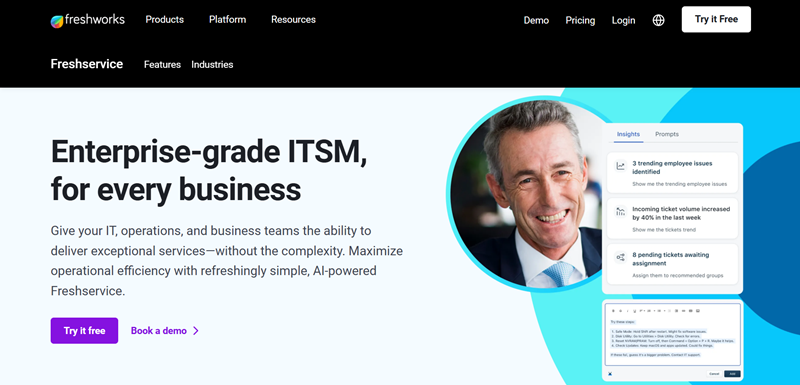
Freshservice is another accessible and easy-to-use ITSM tool that simplifies the user experience without compromising on features too much.
Additionally, Freshservice is also well-known for its rapid implementation while including robust features such as incident and problem management, asset tracking, and an expansive self-service portal.
With its built-in Freddy AI, you’ve got a capable AI ‘chatbot’ that can interact with both the front and backends of your organization to use self-service DIY solutions, speed up resolution times for agents, and provide comprehensive insights for managers.
Key Features:
1. Built-in ‘Freddy’ AI for automated queries and self-service
2. No-code drag-and-drop automation & workflow builder
3. Robust ITOM & ITAM capabilities
Pros:
1. Quick deployment & easy to use UI design
2. Affordable pricing especially for small and medium-sized businesses
Cons:
Limited customization choices
Best For: Small to medium-sized businesses seeking an easy-to-use ITSM tool with robust automation and support.
User Review: 4.6/5 (from G2)
Editor’s Rating:
Automation Capabilities: ⭐⭐⭐⭐
Customization and Flexibility: ⭐⭐⭐
UI Experience: ⭐⭐⭐⭐
4ManageEngine
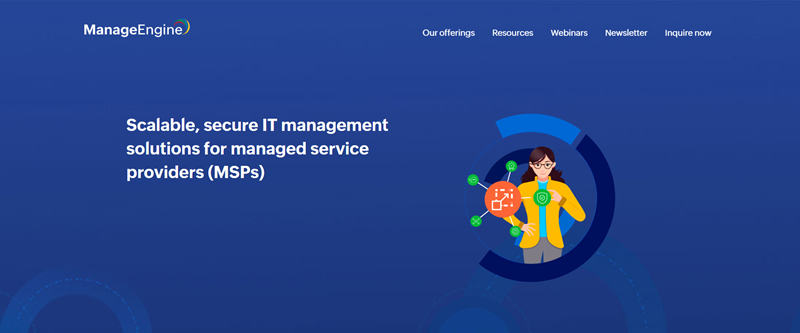
ManageEngine, an extremely capable and customizable ITSM automation platform. The good news is it’s relatively cost-effective when compared to other options, but still provides plenty of customizability to create intricate and unique workflows and automation.
It’s an extremely flexible platform that integrates well with ManageEngine’s other products as well as third-party tools.
ManageEngine also has top-notch security measures with automated security patches & software updates, anomaly detection, and automatic notifications for software license expiration, and ensures compliance with current rules and regulations.
On the other hand, while ManageEngine is plenty capable, some aspects make it less desirable such as the seemingly outdated and unintuitive UI design which can make it more difficult to use.
Key Features:
1. Remote Management capabilities
2. Robust security measures (automated security patches, software updates, anomaly detection & notification)
3. Comprehensive mobile device management app
Pros:
1. Extensive feature set for ITSM use
2. Highly customizable to create tailored workflows & automation
Cons:
Slightly dated & unintuitive UI
Best For: Organizations of all sizes seeking a feature-rich ITSM platform that balances cost and functionality.
User Review: 4.2/5 (from G2)
Editor’s Rating:
Automation Capabilities: ⭐⭐⭐⭐
Customization and Flexibility: ⭐⭐⭐⭐⭐
UI Experience: ⭐⭐⭐
5BMC Helix ITSM
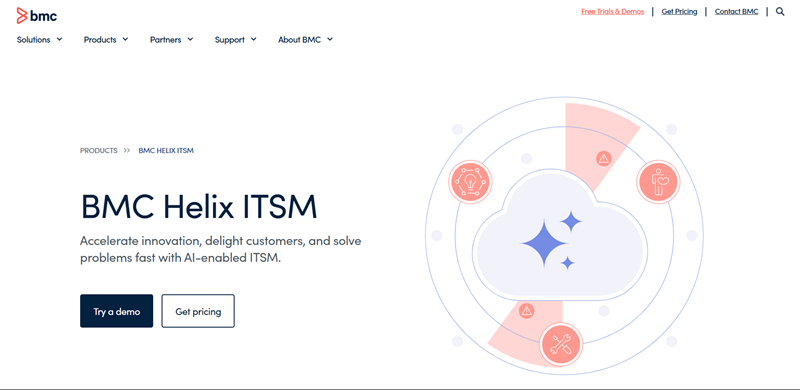
BMC Helix ITSM, a cloud-native and AI-driven ITSM designed to enhance operational efficiency and productivity with powerful features. Some of these include intelligent incident correlations and dynamic service models.
BMC Helix also includes intuitive low-code/no-code tools to streamline processes building out workflows and automation while providing real-time insights bolstered by the built-in AI capabilities.
That said, with all its features and capability, it’s more oriented towards larger organizations with complex IT infrastructures which makes it less accessible for smaller and medium-sized businesses looking for a capable ITSM.
Key Features:
1. Multi-cloud capabilities to manage services across various cloud platforms
2. Integration w/ ServiceOps for causal analysis and AI-driven recommendations
3. Low-code/No-code platform
Pros:
1. AI and ML integration
2. Extensive support for third-party tools
Cons:
Steep learning curve
Best For: Organizations managing complex, multi-cloud environments and needing advanced AI-driven ITSM solutions.
User Review: 3.7/5 (from G2)
Editor’s Rating:
Automation Capabilities: ⭐⭐⭐⭐
Customization and Flexibility: ⭐⭐⭐⭐
UI Experience: ⭐⭐⭐
Part 4: Best Benefits of ITSM Automation
Increased Efficiency
One of the biggest advantages of ITSM automation is the elimination of repetitive manual tasks. This allows IT teams to focus on more strategic initiatives and pressing concerns that AI can’t handle.
Automated workflows and processes also result in a significant productivity gain by reducing the time and effort required to handle incidents, service requests, and system changes.
Faster Response and Resolution Times
Another tangible benefit of ITSM automation is faster response times. By automating tasks like ticket routing, escalation, and resolution, IT techs spend less time on repetitive tasks and instead get direct notifications of pending tasks.
Plus, AI-drive insights can also help identify and address potential issues before they escalate, minimizing downtime and improving service reliability.
Improved Accuracy and Consistency
Human errors do occur pretty regularly, especially when handling complex IT infrastructures. Automation reduces these errors, ensuring consistency in service delivery.
By automating workflows like for change management, these will then follow standardized procedures to reduce risk and ensure compliance with both organization policies and regulatory requirements.
Proactive Problem Management
Augmenting ITSM automation with AI and ML enables proactive problem management by identifying patterns and trends in incident data. With this, organizations can address underlying issues before they happen and become widespread, improving overall system stability.
Part 5: Final Words
And that’s everything you need to know about IT Service Management Automation and hopefully, you’ve got a better idea about ITSM automation and how it can revolutionize your IT processes.
It can be difficult to parse through their pages to understand key differences since many of these types of platforms have almost the same key features, but there are stark differences in the way they’ve implemented their vision.
Focus on finding an ITSM automation tool that supports the same integrations as your existing channels, the UI design, fits into your budget, and has the ‘expertise’ in your specific industry to find the best bang for your buck.








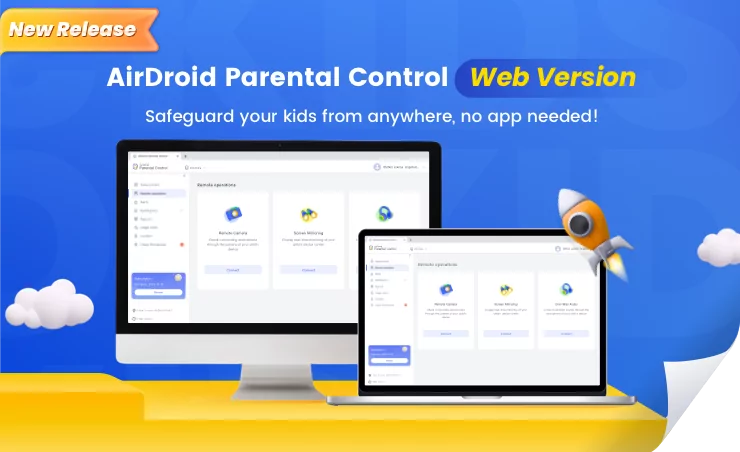


Leave a Reply.